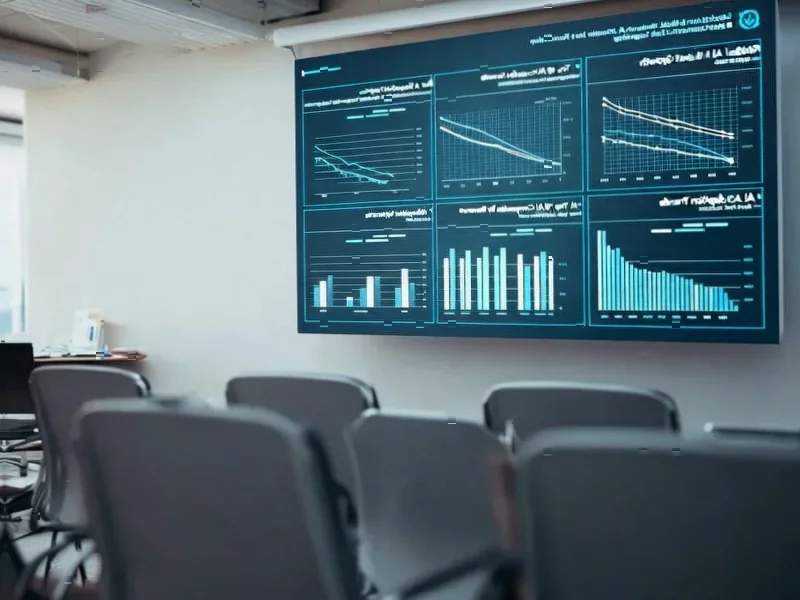According to Forbes, Samsara hosted a webinar last week featuring Tehzin Chadwick, senior vice president of safety at United Natural Foods, Inc. (NYSE: UNFI), and Sanjit Biswas, CEO of Samsara, discussing AI’s role in logistics safety during peak seasons. UNFI, with $32 billion in revenue and 52 distribution centers spanning 30 million square feet, has leveraged earlier seasonal hiring to build cross-trained teams and integrate safety culture before demand spikes. The company uses Samsara’s AI platform for real-time weather alerts, dynamic routing, and in-cab safety notifications, while also implementing AI-driven personalized onboarding and learning pathways for its 25,000+ employees. This comprehensive approach represents a strategic shift from reactive seasonal preparation to proactive year-round safety integration.
From Seasonal Band-Aid to Year-Round Strategy
The most significant revelation from this discussion isn’t the technology itself, but the fundamental shift in approach it enables. For decades, logistics companies treated holiday safety as a temporary problem requiring seasonal solutions—extra training, temporary staff, and intensified monitoring. What UNFI demonstrates is that AI enables a continuous safety infrastructure that scales intelligently rather than reacting desperately. By starting seasonal hiring earlier and using AI to personalize onboarding, they’re treating safety as a foundational element rather than a peak-season concern. This represents a maturation in how major distributors view workforce protection—from cost center to strategic advantage.
The Labor Market Transformation
UNFI’s ability to avoid traditional seasonal hiring pressures while building “stable, cross-trained teams” signals a broader industry transformation. In an era of persistent labor shortages and high turnover—particularly in trucking where drivers frequently change jobs—AI-driven personalization becomes a retention tool, not just a safety measure. The ability to recommend learning pathways and accelerate skill building addresses one of the fundamental drivers of turnover: lack of career progression. When workers see technology helping them advance rather than just monitoring them, adoption increases and retention improves. This creates a virtuous cycle where better-trained workers operate more safely, reducing injuries and further improving retention.
The Weather Intelligence Revolution
Samsara’s advancement in hyper-local weather assessment represents a quantum leap beyond traditional weather apps. As Biswas noted, general weather radar doesn’t indicate whether specific roads are safe—a critical distinction that AI can now address at scale. This capability transforms weather from a generic hazard to a precisely managed variable. The implications extend far beyond holiday seasons to year-round operations across climate-vulnerable regions. As climate change increases weather volatility, this granular understanding of micro-conditions becomes essential infrastructure rather than luxury technology. The ability to message thousands of drivers simultaneously about specific hazards they’re approaching represents a fundamental improvement in risk management.
Warehouse Safety Evolution
Perhaps the most overlooked aspect of this transformation is how AI in demand planning and inventory positioning creates safety benefits. As UNFI’s supply chain initiatives show, reducing unnecessary movements and congestion through better inventory placement directly impacts worker safety. This demonstrates how safety technology is evolving from reactive monitoring (cameras, sensors) to proactive system design. When AI optimizes the entire operational flow, safety becomes embedded in the process rather than added as a protective layer. The integration of robotics, as mentioned with Symbotic, further reduces human exposure to repetitive strain injuries and hazardous manual tasks.
The Coming Regulatory Landscape
As these technologies prove their value in major operations like UNFI’s extensive distribution network, regulatory bodies will inevitably take notice. We’re likely to see OSHA and DOT begin establishing standards for AI-driven safety systems within 18-24 months. Companies that have already integrated these technologies will have significant advantage in compliance and potentially in insurance premiums. The data generated by these systems—proving reduced accidents, better training outcomes, and improved response to hazardous conditions—could become valuable assets in regulatory discussions and insurance negotiations.
Building a Sustainable Workforce
The ultimate impact extends beyond seasonal safety to workforce sustainability. By reducing burnout through better labor alignment, minimizing injuries through personalized training, and creating environments where workers feel protected rather than monitored, companies can build more stable, experienced workforces. This is particularly crucial in an industry facing demographic challenges and increasing competition for talent. The technology described represents a shift from treating workers as replaceable components to valuing them as skilled professionals whose well-being directly impacts operational excellence. In the long term, this approach may prove more valuable than any single technological innovation.




